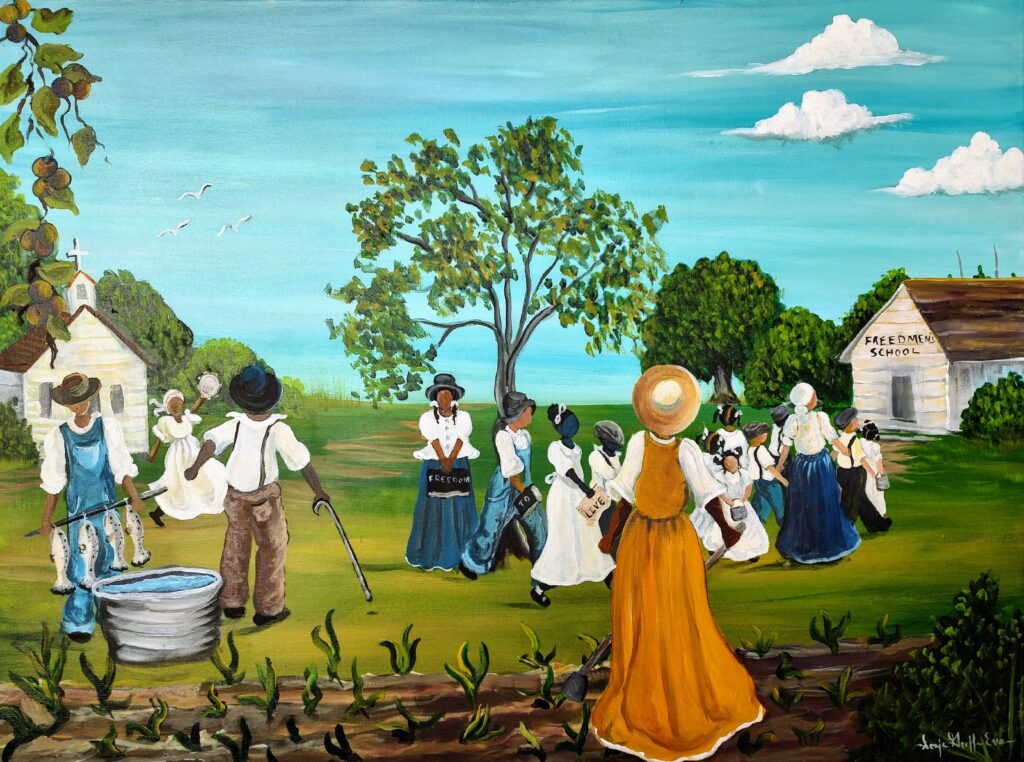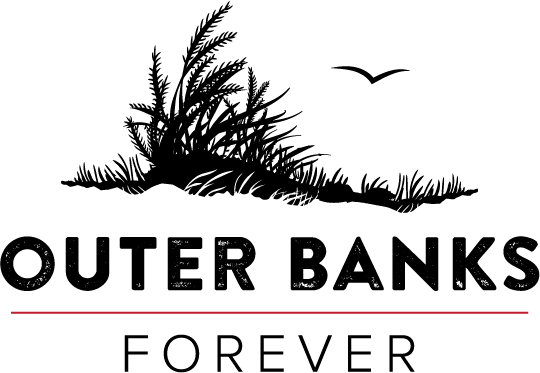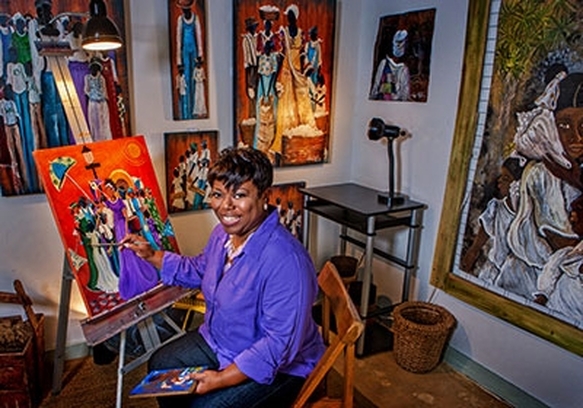By Rachael Graf, Community Engagement Coordinator at Outer Banks Forever
Note: This article was originally published in February 2024.
She has been likened to Michelangelo for her ability to capture the human spirit in and with her work.
And for Sonja Griffin Evans, it all started with a large box of Crayola crayons.
“I am a self-taught artist, believe it or not,” Evans said. “I always kind of dibbled and dabbled as a child in art. However, I’m going to say it all started with that 64 box of Crayola crayons.”
Evans, who is from Beaufort, South Carolina, is an internationally acclaimed, award-winning mixed media artist, painter and arts advocate whose works honor and reflect her Gullah Geechee heritage as well as the diverse cultures, stories and spirituality of people of African descent. Evans is the founder and chair of the National For Artists – By Artists Society, a major contributor in the development for the Forgotten Communities Art Program, director of the Gullah Arts Initiative for the Pan African American Cultural Heritage Initiative, and serves as Senior Fellow for the Pan African Cultural Heritage Institute, Inc. and the National Cultural Heritage Tourism Society.
“I actually started painting in 2005, for therapy. I never thought in a million years that this is what I would be doing,” Evans said. “As I was painting then, I had lost my identity. And as I created different pieces and learned more about my culture, my heritage, my history, it helped me to find who Sonja was.
“What I thought were my last days, were just the beginning for me. Every day that I wake up, every piece that I create, it’s a day that I’m walking in faith, and a day that I’m creating to help show someone else that there is a brighter day. And if my ancestors could go through what they went through and overcame – and then here I am today, being able to tell their stories, and honor their legacy.”
In March of 2017, Evans traveled to Nantes, Cholet and Angers, France, for a three-city solo exhibition tour of her “American Gullah Collection,” which “depicts the unsung pioneers of the Gullah Geechee Cultural Heritage Corridor and of America.”
“When I went to France on the three-city solo exhibition tour, I couldn’t even believe it, being able to tell my story of the Gullah Geechee culture and history,” said Evans. “But then other countries or cities would bring me in to create pieces based around their culture and their history.”
In April of 2023 Evans was commissioned by Fort Raleigh National Historic Site to create a painting for the forthcoming Freedom Trail exhibit at the park, which will help tell the story of the Freedmen’s Colony that thrived on Roanoke Island from 1862 to 1865 and the enduring legacy of the freedom seekers who established new lives for themselves there.

While a 1.25-mile-long, wooded Freedom Trail currently exists at the park, the new exhibit will create an experience that fully brings the stories of the community to life. The new Freedom Trail is made possible by a partnership between local community members who are descendants of members of the Freedmen’s Colony, the National Park Service, Outer Banks Forever and grant funding from the 400 Years of African American History Commission and the National Park Foundation. Once the new Freedom Trail opens to the public, park visitors will have an opportunity to experience Evans’ work in person.
“They [the national parks] are keepers of our history, in a nutshell, and as accurate as you can possibly get,” said Evans. “I’m going to say, for me, creating images for the park service – it’s a way to tell the African American story to as many people as I possibly can.”
When asked what she strives to convey in her work, Evans sums it up in one word: Hope.
“In order for us to understand each other, we have to know a little bit about each other,” said Evans. “In order to respect each other’s culture and each other’s heritage, you have to know something about the person that you’re dealing with or you’re speaking to. And so, for me, that’s what the artwork does.
“The other thing is that when I create these pieces, a lot of times, you’ll see that the people are kind of dressed up a little. That’s the way that I see them because they have done so much for me to be where I am today. I also want to convey that my ancestors were not slaves. They were agricultural engineers, masterful craftsmen and more, who were enslaved because of their skills and their intelligence.”
To create her new painting for the Freedom Trail, Evans traveled to the Outer Banks to meet with descendants of members of the Freedmen’s Colony, as well as park rangers at Fort Raleigh National Historic Site.
“I like to visit the area– it’s almost like this spiritual journey to be able to walk on the land and experience the environment of where the people I’m recreating were on their journey, and of course learn as much as I can of the history of the area,” said Evans.
“I love to talk with some of the local people of the area. When you hear the term ‘African American,’ all African Americans are not the same. Their cultures have some similarities, but not the same. I always want to visit and meet the people and hear the stories of their family members and their ancestors. It gives me a better insight; it helps me to recreate the history or the feeling of the people, their determination, who those people were. It allows me to get to know the person.”
After Evans completed her initial research for her commissioned work, she began painting – a process that is deeply rooted in her faith.
“Once I’ve collected all of that information, I will sit at the canvas and I will just say, ‘Lord, show me what you would like for me to convey,’ and I start,” said Evans. “That’s the thing – the artwork has to speak. If it’s not saying anything, that means you’re not finished, or you need to start over. So, it has to speak to you. It has to tell that story.”
This is not the first time Evans has been commissioned for a work for a National Park Service site. Prior to creating her piece for Fort Raleigh National Historic Site, Evans collaborated with Reconstruction Era National Historical Park in South Carolina and Fort Monroe National Monument in Virginia, the latter for painting for the 1619 anniversary at Fort Monroe – the sobering 400-year anniversary of the arrival of enslaved Africans in North America – of the first family.
“I actually created a piece for the Reconstruction Era National Historical Park, here in Beaufort, for the park service, and then I also allowed them to use some of my images for their Junior Ranger books,” said Evans. “And so, that’s how they found me.
“When Josh [Nelson, former lead ranger at Fort Raleigh National Historic Site] called me, he sent me information about the community, the Freedmen’s Colony. Believe it or not, I had never heard of it. So, when he sent me information that he had – I’m always willing to tell our story. And I think that there are no chance meetings. Everything is for a purpose, a reason and a season. And I am so elated to be able to tell not just African American history, but American history, and our contributions to this country.”
Evans’ desire is for her painting to bring the women, men and children who developed the Freedmen’s Colony to life, creating an intellectual, emotional and spiritual experience for those who spend time on the Freedom Trail.
“Number one, when you hear that terminology ‘the Freedmen’s Colony,’ I want you to be able to put a face [to it] – even though there are no faces in the painting itself – your mind automatically starts to create them. It helps you to look past the physical appearance and look into the spirit and the soul of the people to capture their emotions, their body movements,” said Evans. “I want you to be intrigued, and to learn more about the community and to learn more about what they did during their time and what contributions were made to that area to develop into what it is today.
“Once you learn someone’s story, someone’s history, someone’s journey, you can appreciate it and also respect the person and the people. And that’s what I want people to take away from that particular image, and all of my images. And then also know that you can do it – if they could strive out of the conditions from which they came from and create these colonies and communities and businesses, you too can do it.”
When asked about what she thinks people should know about the Freedom Trail and her artwork’s role in telling the stories of the Freedmen’s Colony, her enthusiasm is evident.
“Okay, well, I have to say this first: They have to know that I am so excited! I am so excited – just to be able to put a picture, an image [to the story] when you go along that trail. There’s something about hearing a story – but when you can visually see it, you get a little bit more,” said Evans. “It becomes real to you; it’s something tangible when you can visually see it.
“I hope that the people who walk through that trail can feel the spirit of the people that lived there. That they can imagine those paintings as a breathing, living, working community, and learn that history. And as they go out into the community around it, they’re able to see the footprints of some of those people.”
Evans’ trip to Fort Raleigh National Historic Site was also her first trip to the Outer Banks, an experience she said she loved.
“It was really creating the painting, but also listening to and meeting some of the descendants, listening to the park rangers. I have to say, they’re so passionate about getting the story out. But it was so much information, so many different aspects of the story to where I couldn’t get it all in just one painting. So, I was like: Okay, I need to create a whole collection on this,” said Evans. “I just wanted that to be a door opener to finding out more and desiring to learn more about that community.
“There’s a lot of gems, diamonds, that people don’t know anything about. And like I said, I am so excited to be chosen to tell some of these stories. I’m learning as I’m creating. I didn’t know I was such a history buff here, but you have to be. With the painting, it’s not just a painting – you’re visually telling and recording a story.”
Throughout her career, Evans has experienced reactions to her work that she said have taken her a little getting used to.
“I have a lot of people who cry,” said Evans. “You make that story and those people human. It’s in a way where the artwork tells the story; it puts the facts on the line. Basically, these are things we have to talk about. You talk about the contributions, but you talk about the situation, the environment in which these things happened. I remember a lady told me one time, ‘Your artwork is so beautiful, but it hurts.’ I told her, ‘Honey, that’s compassion.’”
Evans said she also has had several people say “I never knew that” in response to the stories her works tell.
“Even some people who are even from the area – they never knew anything about that history or anything in particular about that culture,” said Evans. “So, one thing I can say: When people view the work, they are enlightened.”
Evans summed up her motivation for and mission of her work in this way:
“There is only one statement that I have, and it’s that we are the benefactors of our ancestors. And it is up to us to be good stewards of what we have been given,” said Evans. “And so that’s what I try to do with my artwork – collect those stories, the culture, the history, all of the works of my ancestors, and try to capture that in paintings, so those stories, those images, can be here for a lifetime. They’re here forever.”
Artist Photo: Sonja Griffin Evans in her studio. Photo: Sonja Griffin Evans – The Art of Sonja Griffin Evans.

